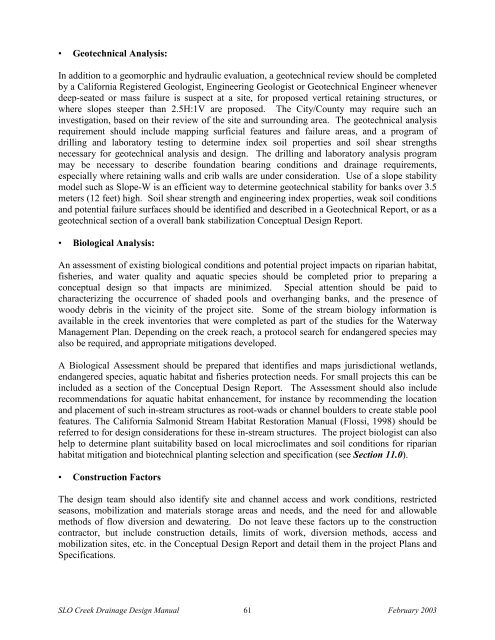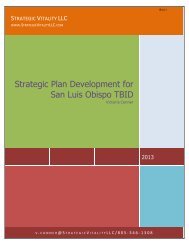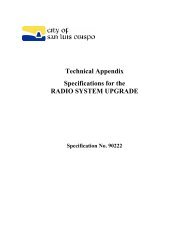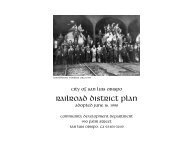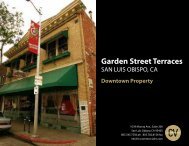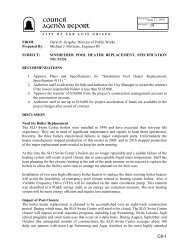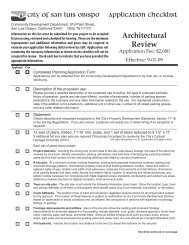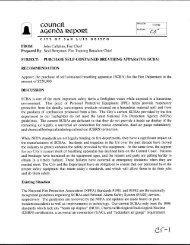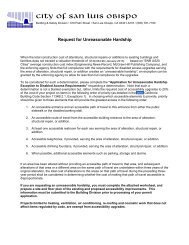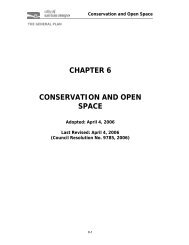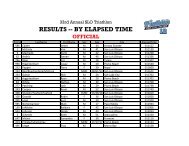Drainage Design Manual - the City of San Luis Obispo
Drainage Design Manual - the City of San Luis Obispo
Drainage Design Manual - the City of San Luis Obispo
Create successful ePaper yourself
Turn your PDF publications into a flip-book with our unique Google optimized e-Paper software.
• Geotechnical Analysis:In addition to a geomorphic and hydraulic evaluation, a geotechnical review should be completedby a California Registered Geologist, Engineering Geologist or Geotechnical Engineer wheneverdeep-seated or mass failure is suspect at a site, for proposed vertical retaining structures, orwhere slopes steeper than 2.5H:1V are proposed. The <strong>City</strong>/County may require such aninvestigation, based on <strong>the</strong>ir review <strong>of</strong> <strong>the</strong> site and surrounding area. The geotechnical analysisrequirement should include mapping surficial features and failure areas, and a program <strong>of</strong>drilling and laboratory testing to determine index soil properties and soil shear strengthsnecessary for geotechnical analysis and design. The drilling and laboratory analysis programmay be necessary to describe foundation bearing conditions and drainage requirements,especially where retaining walls and crib walls are under consideration. Use <strong>of</strong> a slope stabilitymodel such as Slope-W is an efficient way to determine geotechnical stability for banks over 3.5meters (12 feet) high. Soil shear strength and engineering index properties, weak soil conditionsand potential failure surfaces should be identified and described in a Geotechnical Report, or as ageotechnical section <strong>of</strong> a overall bank stabilization Conceptual <strong>Design</strong> Report.• Biological Analysis:An assessment <strong>of</strong> existing biological conditions and potential project impacts on riparian habitat,fisheries, and water quality and aquatic species should be completed prior to preparing aconceptual design so that impacts are minimized. Special attention should be paid tocharacterizing <strong>the</strong> occurrence <strong>of</strong> shaded pools and overhanging banks, and <strong>the</strong> presence <strong>of</strong>woody debris in <strong>the</strong> vicinity <strong>of</strong> <strong>the</strong> project site. Some <strong>of</strong> <strong>the</strong> stream biology information isavailable in <strong>the</strong> creek inventories that were completed as part <strong>of</strong> <strong>the</strong> studies for <strong>the</strong> WaterwayManagement Plan. Depending on <strong>the</strong> creek reach, a protocol search for endangered species mayalso be required, and appropriate mitigations developed.A Biological Assessment should be prepared that identifies and maps jurisdictional wetlands,endangered species, aquatic habitat and fisheries protection needs. For small projects this can beincluded as a section <strong>of</strong> <strong>the</strong> Conceptual <strong>Design</strong> Report. The Assessment should also includerecommendations for aquatic habitat enhancement, for instance by recommending <strong>the</strong> locationand placement <strong>of</strong> such in-stream structures as root-wads or channel boulders to create stable poolfeatures. The California Salmonid Stream Habitat Restoration <strong>Manual</strong> (Flossi, 1998) should bereferred to for design considerations for <strong>the</strong>se in-stream structures. The project biologist can alsohelp to determine plant suitability based on local microclimates and soil conditions for riparianhabitat mitigation and biotechnical planting selection and specification (see Section 11.0).• Construction FactorsThe design team should also identify site and channel access and work conditions, restrictedseasons, mobilization and materials storage areas and needs, and <strong>the</strong> need for and allowablemethods <strong>of</strong> flow diversion and dewatering. Do not leave <strong>the</strong>se factors up to <strong>the</strong> constructioncontractor, but include construction details, limits <strong>of</strong> work, diversion methods, access andmobilization sites, etc. in <strong>the</strong> Conceptual <strong>Design</strong> Report and detail <strong>the</strong>m in <strong>the</strong> project Plans andSpecifications.SLO Creek <strong>Drainage</strong> <strong>Design</strong> <strong>Manual</strong> 61 February 2003


